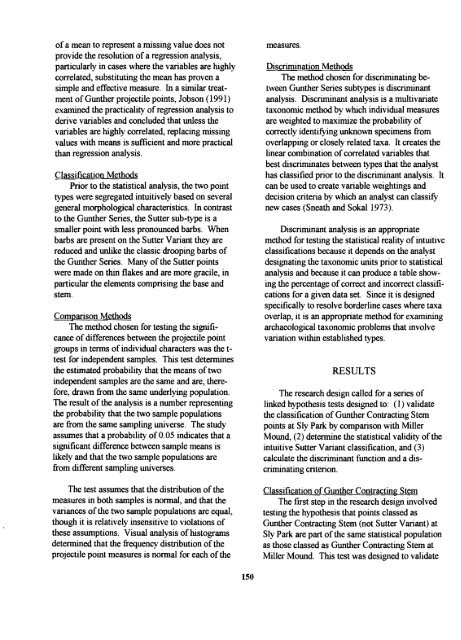a statistical analysis of gunther series projectile - Society for ...
a statistical analysis of gunther series projectile - Society for ...
a statistical analysis of gunther series projectile - Society for ...
Create successful ePaper yourself
Turn your PDF publications into a flip-book with our unique Google optimized e-Paper software.
<strong>of</strong> a mean to represent a missing value does not<br />
provide the resolution <strong>of</strong> a regression <strong>analysis</strong>,<br />
particularly in cases where the variables are highly<br />
correlated, substituting the mean has proven a<br />
simple and effective measure. In a similar treat~<br />
ment <strong>of</strong> Gunther <strong>projectile</strong> points, Jobson (1991)<br />
examined the practicality <strong>of</strong> regression <strong>analysis</strong> to<br />
derive variables and concluded that unless the<br />
variables are highly correlated, replacing missing<br />
values with means is sufficient and more practical<br />
than regression <strong>analysis</strong>.<br />
Classification Methods<br />
Prior to the <strong>statistical</strong> <strong>analysis</strong>, the two point<br />
types were segregated intuitively based on several<br />
general morphological characteristics. In contrast<br />
to the Gunther Series, the Sutter sub-type is a<br />
smaller point with less pronounced barbs. When<br />
barbs are present on the Sutter Variant they are<br />
reduced and unlike the classic drooping barbs <strong>of</strong><br />
the Gunther Series. Many <strong>of</strong>the Sutter points<br />
were made on thin flakes and are more gracile, in<br />
particular the elements comprising the base and<br />
stem.<br />
Comparison Methods<br />
The method chosen <strong>for</strong> testing the significance<br />
<strong>of</strong> differences between the <strong>projectile</strong> point<br />
groups in terms <strong>of</strong> individual characters was the t<br />
test <strong>for</strong> independent samples. This test determines<br />
the estimated probability that the means <strong>of</strong> two<br />
independent samples are the same and are, there<strong>for</strong>e,<br />
drawn from the same underlying population.<br />
The result <strong>of</strong> the <strong>analysis</strong> is a number representing<br />
the probability that the two sample populations<br />
are from the same sampling universe. The study<br />
assumes that a probability <strong>of</strong> 0.05 indicates that a<br />
significant difference between sample means is<br />
likely and that the two sample populations are<br />
from different sampling universes.<br />
The test assumes that the distribution <strong>of</strong> the<br />
measures in both samples is normal, and that the<br />
variances <strong>of</strong>the two sample populations are equal,<br />
though it is relatively insensitive to violations <strong>of</strong><br />
these assumptions. Visual <strong>analysis</strong> <strong>of</strong> histograms<br />
determined that the frequency distribution <strong>of</strong> the<br />
<strong>projectile</strong> point measures is normal <strong>for</strong> each <strong>of</strong> the<br />
measures.<br />
Discrimination Methods<br />
The method chosen <strong>for</strong> discriminating between<br />
Gunther Series subtypes is discriminant<br />
<strong>analysis</strong>. Discriminant <strong>analysis</strong> is a multivariate<br />
taxonomic method by which individual measures<br />
are weighted to maximize the probability <strong>of</strong><br />
correctly identifYing unknown specimens from<br />
overlapping or closely related taxa. It creates the<br />
linear combination <strong>of</strong> correlated variables that<br />
best discriminates between types that the analyst<br />
has classified prior to the discriminant <strong>analysis</strong>. It<br />
can be used to create variable weightings and<br />
decision criteria by which an analyst can classifY<br />
new cases (Sneath and Sokal1973).<br />
Discriminant <strong>analysis</strong> is an appropriate<br />
method <strong>for</strong> testing the <strong>statistical</strong> reality <strong>of</strong> intuitive<br />
classifications because it depends on the analyst<br />
designating the taxonomic units prior to <strong>statistical</strong><br />
<strong>analysis</strong> and because it can produce a table showing<br />
the percentage <strong>of</strong> correct and incorrect classifications<br />
<strong>for</strong> a given data set. Since it is designed<br />
specifically to resolve borderline cases where taxa<br />
overlap, it is an appropriate method <strong>for</strong> examining<br />
archaeological taxonomic problems that involve<br />
variation within established types.<br />
RESULTS<br />
The research design called <strong>for</strong> a <strong>series</strong> <strong>of</strong><br />
linked hypothesis tests designed to: (I) validate<br />
the classification <strong>of</strong> Gunther Contracting Stem<br />
points at Sly Park by comparison with Miller<br />
Mound, (2) determine the <strong>statistical</strong> validity <strong>of</strong> the<br />
intuitive Sutter Variant classification, and (3)<br />
calculate the discriminant function and a discriminating<br />
criterion.<br />
Classification <strong>of</strong> Gunther Contracting Stem<br />
The first step in the research design involved<br />
testing the hypothesis that points classed as<br />
Gunther Contracting Stem (not Sutter Variant) at<br />
Sly Park are part <strong>of</strong> the same <strong>statistical</strong> population<br />
as those classed as Gunther Contracting Stem at<br />
Miller Mound. This test was designed to validate<br />
150
















